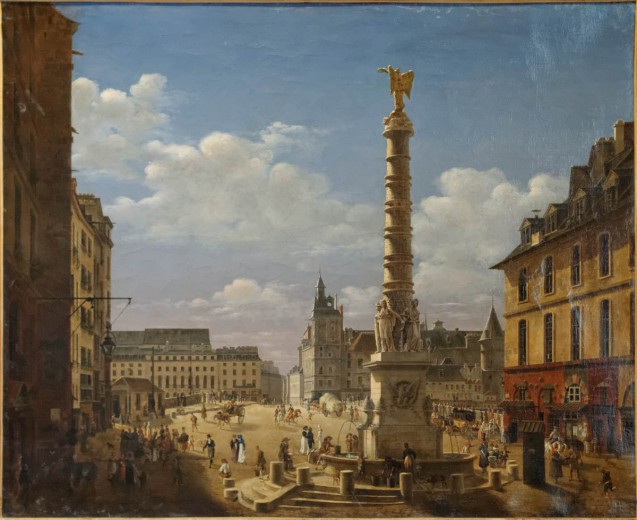In 1810, Parisians and tourists to the French capital had the privilege of visiting this beautiful square, at whose centre stood the majestic Fontaine du Palmier commemorating the victories of Napoleon’s Grande Armée.
Until 1802, the scene had been dominated by the Grand Châtelet, a 9th century fortress reconstructed in stone and extended in the 12th century by Louis VI, in an attempt to consolidate the capital’s defences. This castle on the Right Bank faced the Pont au change bridge, the latter a busy thoroughfare packed with stalls. At the end of the 12th century, the Grand Châtelet became the central office of the police and criminal justice system, known as the Prévôté. It was also an infamous prison, at a time when torture formed a necessary prerequisite to confession and the living conditions of detainees were fatally insalubrious.
Despite the fact that the destruction of the Grand Châtelet had been decided by the revolutionary government in September 1792, demolition did not begin until 1802, and it was to last eight years. Also removed at the time was the major market in the place de l’Apport-Paris. The aim was to open up access to the rue Saint-Denis and the Pont au change and to improve the infrastructure of this dense urban quarter.
On 2 May 1806, Napoleon I issued a decree providing fifteen new fountains for Paris, thereby attempting to improve city’s extremely poor network of free drinking water. Among these was the fontaine du Châtelet, with its decorative scheme celebrating a series of Napoleonic victories, whose names (Lodi, Arcole, Rivoli, Pyramids, Mont Thabor, Marengo, Austerlitz, Ulm, Jena, Eylau, Danzig and Friedland) were inscribed in friezes around the shaft of the column surmounting the fountain proper. The capital of the column, with its palm frieze, was to provide the inspiration for the name, Fontaine du Palmier. The sculptor Louis Boizot (1743-1809) was commissioned to construct not only the statue of Victory which stands at the summit of the column, but also the cardinal virtues of Prudence, Temperance, Justice and Strength set around its base. Water flowed into the basin from horns of plenty decorated with dolphin heads. The large basin and the pedestal of sphinx heads were added to the monument in 1858, when the fountain was temporarily moved during Haussmann’s renovations of the square. Boizot’s Winged Victory was to be replaced by a copy in 1898 and the original is now kept in the gardens of the Musée Carnavalet (Paris).
The painting shown here is by Etienne Bouhot (1780-1862), a pupil of Pierre Prévost, principal panorama painter, a genre very much in vogue during the Empire period. Bouhot had already been successful with a painting of an architectural work, when he exhibited at the Salon of 1808 an image of Place Vendôme and its column under construction. At the following Salon of 1810, he bet on the same horse with this picture of La fontaine et la place du Châtelet en 1810, for which he received a bronze medal. In this more masterly work, Bouhot portrays the vibrant bustle around the fountain and in the square. Both pictures are eloquent testimonials to Napoleon’s little-known role as Parisian urbanist.
Irène Delage, trans. Syamala Roberts
March 2015


